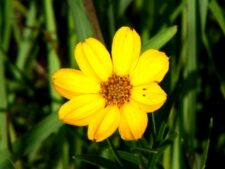
FINGER COREOPSIS
Coreopsis palmata
SUNFLOWER FAMILY (Asteraceae)
 Identification
Identification
- Flowering time - June, July
- Uncommon in prairies at NW
- Leaves with 3 finger-like lobes
- Short sunflower with yellow central disk
- Plains Coreopsis (C. tinctoria) has narrower, more deeply divided leaves and a dark central disk
This native perennial grows from 1 to 3 feet tall. Stiff stems hold opposite leaves 2-3 inches long which are divided to about their midpoint into three narrow lobes or “fingers” (A). Erect stalks support from one to several 1-2 inch flower heads. From 6-10 petal-like ray florets surround the yellow disk florets (B). Tips of the ray florets are often notched.
Found in dry prairies and open woodland, flowering in June and July. It is uncommon in some Neale Woods prairie restorations. There are no recent records from Fontenelle Forest.
Characteristic 3-lobed, crowfoot-like leaves and yellow disk florets separate this plant from Plains Coreopsis (Coreopsis tinctoria), a species likely in this area and observed in the past, although not recently, at Neale Woods. Plains Coreopsis has very narrow, more deeply divided leaves, ray flowers with a reddish-brown basal spot, and reddish to purple disk florets.
Coreopsis, a word of Greek origin, meaning “having a bug-like appearance” and the alternate common name Tickseed both refer to the insect-like shape of the small, brown seed. Other common names include Prairie Coreopsis, and Stiff Coreopsis.
The content of NatureSearch is provided by dedicated volunteer Naturalists of Fontenelle Forest who strive to provide the most accurate information available. Contributors of the images retain their copyrights. The point of contact for this page is: Neal Ratzlaff.

